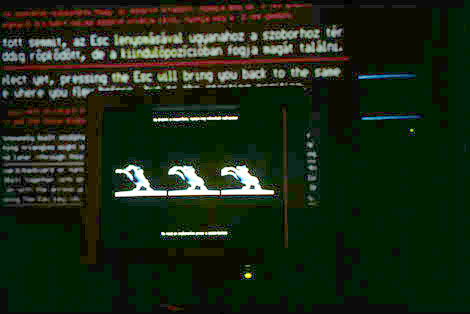
|
|
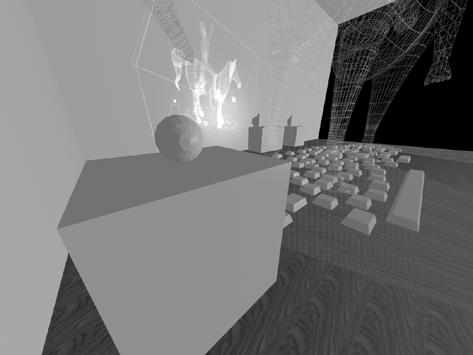
Keyboards and mice connected to our home-computers are undoubtedly unqualified to give us the ability to take the full advantages of today's digital automates features. To be in line with the intellectuality of the exhiubition "Butterfly Effect", I propose two closely related projects as a memorial to the momentary cybercpace of keyboards and mice. Together they form an interactive environment, but I will publish both of them separately on removable hard-disks or on CD for "home-entertainment".
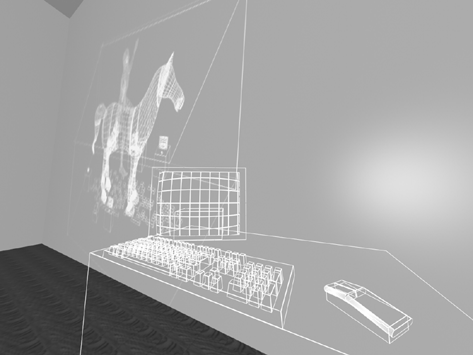
All virtual 3D objects' surface are constructed of triangles tightened on points in the virtual space. The basic idea of this piece is to link these points to characters of the US International characterset. This way the "user" can write into the 3D cyberspace: each 3 characters typed on the keyboard appoints (by settling 3 points in the cyberspace) a triangle in the computer-space. By a simple VR interface/program the visitor of the exhibition can immediately watch/enjoy his/her own creation: they can openly fly around the continuously built sculpture.
The virtual object I use in this work is a model of a sculpture, building or something like that which has never been realized. Until this time I haven't decided, yet but - as you see on the renderings - I'm working on the model of Leonardo's Sforza-statue, using Leonardo's sketches.
The virtual sculpture being constructed will not nearly resemble the original, since the triangle-shapes will not come into existence in the same order/arrangement like the "original modelling". Thus the variations of the resulting objects seems infinite. My intention (guided by my technical possibilities) is to use cheap equipments: home computers and home made cheap interfaces. As a favourable result the spectacle will be draft, low resolution - hardly tasting of (pre-historic-)computers. The virtual sculpture and the text just typed in will be alternately shown on a video-projector.
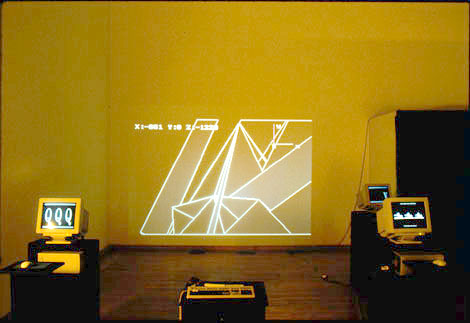
The "original" model of the Sforsa-statue can be studied on a large screen, with the help of the mouse. A film made from a viewpoint of a camera flying around the sculpture can be examined in the following way: the user have to move the mouse to "move the movie". Like a flywheel-car the motion picture stops after a while if the mouse remains untouched, and the last frame (as a still image) is shown until someone moves again the "flywheel-mouse". The same way the visitor can examine all the text typed in since the opening of the exhibition. The letters vertically fill the screen, thus at once 3 letters can be seen on the monitor.
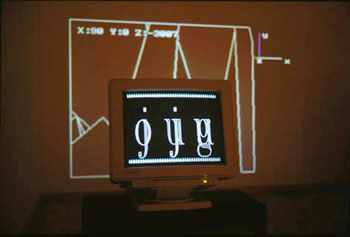
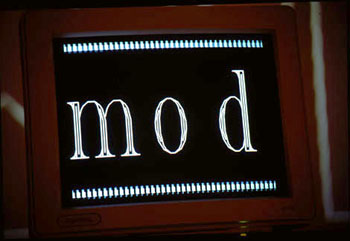
The VR and the text-input program run on the same computer (No. 1). Thus the visitor has to select between the "text input" and the "VR look around" operations. During "text input" the actual charaters are projected, otherwise the cyber-scene is shown. The typeing is practicable on a simple keyboard, while the VR interface is a more intelligent, but still cheap, home-made system. (Something like a position sensor, preferabbly with own processor and memory to process the coordinate-datas, but maybe a trackball is more than enough for my purpose.)
A second computer (No. 2) is used for examining the whole text has being typed in since the opening with the help of the "flywheel mouse".
The third PC (No. 3) works similar to the second, an already rendered endless animation is shown ("flywheel-version" too) about the "original model" as it stands in the exhibition-hall, piercing through the ceiling. The real phisical objects standing in the room are rendered in wireframe-style, only the sculpture seems to be realistic.
